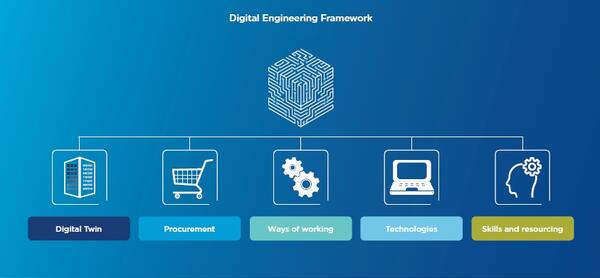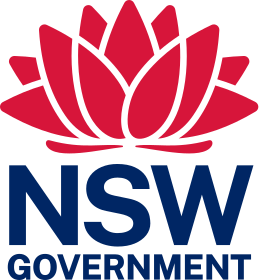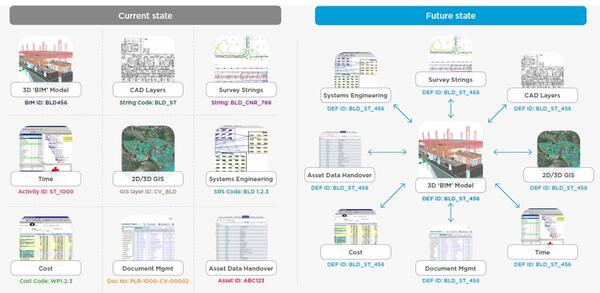
The Digital Engineering Framework
Since the launch of the Digital Engineering (DE) Framework in September 2018, there have been a series of releases, adding additional capabilities and updating key documents to reflect lessons learned on pilot projects.
The DE Framework will continue to develop new capabilities, whilst working closely with projects as they embrace new digital ways of working.
Document library
This library contains many of our key documents released since the DE Framework launched in September 2018. These documents support both the Client-side and Contractors, and include technical guides, procurement / contract documents, management plan documents and a range of tools and templates.
There are some additional documents that are available to Transport staff and our DE Projects. If you're interested in a particular document that's not publicly available, please email us at Digital.Engineering@transport.nsw.gov.au
Document types
Transport requirements
| DE discipline | Publication date | Document no. | Document title | Document purpose |
|---|---|---|---|---|
| DE management | December 2022 | DMS-ST-208 | Digital Engineering Framework | This document provides an overview of the scope and purpose of the DE Framework, including resources available, and its utilisation over the project lifecycle. |
| DE management | December 2022 | DMS-ST-202 | Digital Engineering Standard - Part 1: Concepts and Principles | This document provides an overview of Transport's operating environment and DE concepts. |
| DE management | December 2022 | DMS-ST-207 | Digital Engineering Standard - Part 2: Requirements | This document details the management requirements and technical outputs (deliverables/submissions) required during the delivery of a Transport DE-enabled project. |
| DE management | December 2022 | DMS-SD-123 | Digital Engineering terms and definitions | This document explains DE terms, phrases and acronyms, as used by Transport. |
| Survey | December 2022 | DMS-FT-493 | Utility Schema and Specification | This schema outlines the format and data requirements to be followed when creating utility survey deliverables. |
| BIM | December 2022 | DMS-FT-516 | BIM Schema and Specification | This supporting document provides modelers with clearer, more detailed level of specification as to the information to be included in the BIM model. This document has been written to complement Table 34: Model Properties Requirements in the DE Standard (DMS-ST-207). Supersedes Model Properties Specification (SD-133). |
| CAD | December 2022 | DMS-FT-562 | CAD Schema and Specification | This schema outlines the format and data requirements to be followed when creating CAD deliverables. |
| GIS | December 2022 | DMS-FT-580 | GIS Schema | This schema outlines the format and data requirements to be followed when creating GIS deliverables. |
| GIS | Dec 2022 | IP-0048-SP01 | Aboriginal Heritage Assessments GIS Specification | This specification details the requirements for Geographic Information System (GIS) Datasets, relating to Aboriginal Heritage assessments, provided to Transport for New South Wales (TfNSW) typically through minor works contracts. It is intended to support Aboriginal Heritage experts to deliver GIS data that complies with the DE Framework. |
| GIS | Dec 2022 | IP-0048-SP02 | Biodiversity Assessments GIS Specification | This specification details the requirements for Geographic Information System (GIS) Datasets, relating to biodiversity assessments, provided to Transport for New South Wales (TfNSW) typically through minor works contracts. It is intended to support Biodiversity Assessment experts to deliver GIS data that complies with the DE Framework. |
| Information Management | December 2022 | DMS-FT-533 | Enterprise Content Management (ECM) Schema and Specification | This schema specifies the format and any data requirements to be complied with for the configuration of the projects' ECM tool. It includes project-specific fields which must be defined by the Transport project team prior to implementation. |
| Systems Engineering | June 2024 | DMS-FT-563 | Requirements Schema and Specification for DE Projects | This schema specifies the format and any data requirements to be complied with during the definition and management of project requirements. It is designed to comply with T MU AM 06004 ST Requirements Schema, incorporating appropriate PDBB to standardise and align with other project data. |
| Time | Sept 2024 | DMS-FT-520 | Scheduling Schema and Specification | This schema defines a standard structure for the organisation of project activities in Primavera P6. |
Delivery tools and templates
| DE discipline | Publication date | Document no. | Document title | Document purpose |
|---|---|---|---|---|
| BIM Models | September 2023 | DMS-FT-454 | Model Property Check Template | This template provides a visual report format for compliance results of BIM model attributes compared with the BIM Schema. |
| Asset Data | June 2025 | DMS-FT-537 v4.4 | Asset Register Template | This template provides the minimum fields required to allow auto-population and validation with the BIM model. Extra data requirements are to be appended as required by T MU AM 02001 ST Asset Information and Register Requirements. |
| BIM | December 2022 | DMS-FT-534 | Model Production and Delivery Table (MPDT) Template | This template provides a standard structure for the documentation and communication of models to be produced during the project, who is responsible in the team for delivery, the LoD required at defined milestones and the model-level classification. |
| BIM | December 2022 | DMS-FT-556 | Digital Engineering Validation Certificate | This template provides a checklist and an indication from the project team to Transport that the BIM model submission has been developed as per the project requirements. |
| CAD | December 2023 | DMS-FT-549 | DE CAD Title Block Standard Format | This template provides the approved layout and data inclusions for title blocks on DE CAD deliverables. This template is to be utilised for delivery of both road (RMS) and rail (Sydney Trains) CAD deliverables. |
| DE Management | October 2023 | DMS-FT-532 | Digital Engineering Execution Plan (DEXP) Template | This template provides a standardised format and contents for the DE Manager on a project to document, agree and communicate to the delivery team how DE is to be used for project delivery, the deliverables requirements and processes and tools to be implemented to facilitate DE delivery. The template provides guidance to users and cross-reference to the updated Digital Engineering Standard and other DE Framework documents. |
| DE Management | April 2021 | DMS-FT-443 | DE Responsibility Matrix (XLSX, 707.46 KB) | This template provides a standard format for projects to allocate DE responsibilities to team members, providing visibility and accountability. |
| Information Management | December 2022 | DMS-FT-555 | Master Information Delivery Plan (MIDP) Template | This template provides project teams with a tool to communicate information deliverables (NB this includes internal project deliverables as well as formal submissions to Transport), when they are required and who is responsible. This will help the contractor to interpret contract requirements correctly and sets expectations/confirms scope between Transport and the contractor. |
| GIS | December 2022 | IP-0048-TL01 | Template file structure for Aboriginal Heritage Assessments GIS | This template provides a geodatabase file and file structure to support Aboriginal Heritage experts to deliver GIS data that complies with requirements specified in Digital Engineering Framework, G75, and IP-0048-SP01 documents. |
| GIS | December 2022 | IP-0048-TL02 | Template file structure for Biodiversity Assessments GIS | This template provides a geodatabase file and file structure to support Biodiversity Assessment experts to deliver GIS data that complies with requirements specified in Digital Engineering Framework, G75, and IP-0048-SP01 documents. |
| GIS | December 2022 | IP-0048-TL03 | Template file structure for GIS | This template provides a geodatabase file and file structure that is intended to support the delivery of GIS data that complies with requirements specified in Digital Engineering Framework, G75, and DMS-FT-580 documents. |
| Survey | December 2022 | IP-0043-GD01 | Survey Schema and Specification | This schema outlines the format and data requirements when creating Survey deliverables for a project. |
Technical Guidance
| DE discipline | Publication date | Document no. | Document title | Document purpose |
|---|---|---|---|---|
| All | OCT 2019 | DMS-SD-140 | Project Deliverables Requirements Guide | This guide provides a summary of the deliverables required by the DE Standard and indication of when in the project lifecycle they are required and to what detail. |
| Asset Data | December 2022 | DMS-SD-138 | Why not COBie? | This guide provides an overview of the reasons that Transport does not require compliance with COBie. |
| Asset Data | August 2025 | DMS-SD-141 | Master Classification Library | This guide provides a list of common locations and assets within the Transport portfolio and their classification. A code is also provided, based on ASA’s T MU AM 02002 TI Asset Classification System. For projects using the DE Framework, the requirement for aligning the handover asset register with T MU AM 02002 TI Asset Classification System remains with Transport. |
| BIM | December 2022 | DMS-SD-136 | Setting up for BIM | This guide is aimed at the Contractor and provides advice on how to set up for modelling appropriately so that Transport’s requirements are met over the course of the design process. This will reduce rework and ensure the integrity of the model. |
| CAD | Oct 2019 | DMS-SD-139 | The DE CAD Concession | This guide details why a CAD concession has been requested for our Pilot Projects, what the concession aims to achieve and what projects are impacted. |
| DE Management | December 2022 | DMS-SD-124 | TfNSW Application of Uniclass | This guide provides an overview of what Uniclass 2015 is and why it has been adopted by Transport. It also describes how it is to be implemented on Transport projects. |
| DE Management | December 2022 | DMS-SD-125 | Establishing the Contractor CDE | This guide provides guidance to Contractors on how to set up a Contractor Common Data Environment (CDE) in line with the principles of the DE Framework, achieving consistency in fundamental CDE principles, applying the project data schema, security and on-boarding staff. |
| DE Management | December 2022 | DMS-SD-149 | Using the DEXP | This guide provides an overview of the purpose and benefits of a DEXP and where it fits within the contract management plan suite. It explains the structure and content of a DEXP and details how the DEXP is managed over the life of the project. |
| DE Management | December 2022 | DMS-SD-130 | Visualisation Requirements Guide | The purpose of this guide is to establish a common approach to develop the requirements that define how visualisations should be delivered for a project. It should be used by the project team when setting the project specific. |
| Information Management | December 2022 | DMS-SD-144 | The MIDP Guide | This guide provides an overview of what an MIDP is and the benefits of using an MIDP during project delivery. Further, it provides users with advice on how to set up and use the MIDP. |
| GIS | February 2024 | DMS-FT-581 | GIS Management Plan (GISMP) Template (DOCX, 310.17 KB) | This guide provides a template to comply with Transport GIS requirements specified in Digital Engineering G75 and GIS Schema (DMS-FT-580) documents |
| Survey | December 2022 | DMS-SD-142 | Digital Engineering Survey Requirements Guide | The purpose of this guide is to set a standard approach for procuring and delivering spatial data (digital surveys) to support Transport for NSW (TfNSW) digital engineering enabled projects. The guide and survey schema have been developed to integrate with TfNSW Digital Engineering (DE) Framework. The guide can also be applied to projects outside this framework. |
Objectives
Image

Image controls:
The DE Framework focuses on five key objectives, driving a consistent approach to DE and allowing projects to simply and rapidly adopt DE.
Find out about the capabilities and benefits of each of these objectives below.
Digital Twin
| Capabilities | Benefits |
| Laser scanning and point clouds | Better site investigation and design inputs |
| Coding and tracking of sub-surface utilities | Improved modelling of underground conditions |
| 3D modelling and design collaboration | Less design changes and construction variations |
| Review design and construction methodology using 4D models | Greater design insights and faster approvals |
| Visualisation using AR & VR | Improved stakeholder consultation |
Procurement
| Capabilities | Benefits |
| Agreed commercial and legal framework for DE | More clarity on DE governance for projects |
| Standardised approach with template documents | Faster, more consistent DE tender preparation |
| Scalable, integrated procurement processes | Less complexity and improved tender responses |
| Guidance and technical support for DE procurement | More informed DE tender assessment |
| Expertise to support project initiation | Smoother project start-up |
Ways of working
| Capabilities | Benefits |
| DE Standard and technical guides | Standardised work practices and deliverables |
| Smarter searching capabilities | Faster, more informed decisions |
| Deliverables specified in open data formats | Future-proofed data for re-use |
| High quality modelling and 3D visualisation | Greater insights for value engineering and improved customer outcomes |
| Digital asset handover processes | More efficient and effective transition to O&M |
Technologies
| Capabilities | Benefits |
| Data storage & exchange in common environment | Secure data access for multiple project parties |
| IT platform pre-configured to enable DE processes | Faster, consistent setup for new projects |
| DE data accessible on mobile platform | Offsite access to drawings and project information |
| Software for reviewing BIM models | Faster, more informed approval |
| Bulk production drawings from 3D model | Less admin and more efficient data processing |
Skills and resourcing
| Capabilities | Benefits |
| Consistent understanding of DE | Practical knowledge of DE and the DEF |
| Role specific training for DEF elements | Improved internal capability for DE management |
| New skills for procurement & project management | Improved tender assessment and project outcomes |
| New skills and tools for design review and approval | Improved assurance of project deliverables |
| Pre-approved panel offering DE services and subject-matter experts | Access and rapid procurement of industry DE expertise |
Creating a data-centric network
The success of DE is dependent on consistent and reliable data and information that’s managed as an asset, and maintained throughout project delivery and asset operations and maintenance. That is why consistent and scalable processes are vital.
To achieve DE’s full benefits, Transport is committed to making more informed, data-driven decisions, with the development of the DE Framework. We’re striving to create a unified, reliable and reusable approach to DE, and to supporting its implementation throughout our organisation.
Current state vs Future state
The DE Framework will bring together systems and related data sets into a Common Data Environment (CDE), proving access to geometric and non-geometric data and information. Once these data sets come together, they provide valuable insights, by telling the full story of an asset.
Project Data Building Blocks - Connecting Emerging Technologies
Emerging technologies are enhancing project outcomes and producing data and information at rates we’ve never seen before. This creates its own unique challenges. When data is restricted within Project disciplines, the full value can never be realised.
The DE Framework solves this by creating a universal system for defining and managing data and relating information to assets through all stages of a project lifecycle. We call this the Project Data Building Blocks. Watch the video below to find out more.
Image
Image controls:
The Future of the DE Framework
Transport is committed to the development of the DE Framework, refining our approach as the DE technology continues to mature. The DE Framework will remain focused on supporting current project delivery, while discovering, testing and embracing industry best practices as they evolve.
FAQ’s
Our Frequently Asked Questions are a great starting point if you have any questions.

